Matador Network's Blog, page 2251
June 26, 2014
Exploring East Greenland [pics]
Greenland is a country divided by the ice, with the west and east both linguistically and historically very different. By far the majority of the population, 52,000 out of only 56,000 people, lives in the west, and since this is the world’s largest island it actually makes us the least populated country in the world.
One of the great benefits of a land as vast as Greenland is the opportunity to be a domestic traveler and feel like you’re going off the edge of the map.
Before recently moving to Greenland’s capital Nuuk, I lived in Sisimiut, the second-largest town in the country. 5,500 people live on a tiny, rocky promontory just north of the Arctic Circle, and to us “over here” on the west coast, generally East Greenland is “over there.” In fact, the west Greenlandic word for East Greenland is “Tunu,” which means “the backside.”
For me, as for so many other people, traveling is all about exploring the “backsides” of our world.
In mid-July last year I arrived in the main airport of Kulusuk, a gravel airstrip outside a village of about 250 people, via Reykjavik, which is the easiest way to get there. Greenland to Iceland and then back to Greenland — that’s how to start a domestic journey around here. I hooked up with a group of hikers trekking through the mountains along the huge Sermilik Ice Fjord for four days. I was thrown headfirst into the adventure with a five-hour boat ride through ice-packed fjords and sounds, and dropped off in a camp so remote that all locals carry a gun for polar bear protection.
From our inland position we trekked south along Sermilik to the tiny village of Tiniteqilaaq, right on the edge of the ice fjord, where people live off hunting in the rich fjord waters. At times along the trek the locals ferried us across narrow straits and along too-rugged-to-hike coastlines in what outsiders often think of as a roadless land — but up here the roads are waterways, flight paths, dog sled routes, and snowmobile trails that require ancient knowledge combined with modern navigational equipment.

A small boat navigates the maze of icebergs in the Sermilik Ice Fjord near Tiniteqilaaq. All photos by author.

The jagged peaks of the Tasiilaq backcountry are dotted with glaciers and rise straight out of the fjords.

A sled dog in Tiniteqilaaq looks out over the Sermilik Ice Fjord from its summer home.
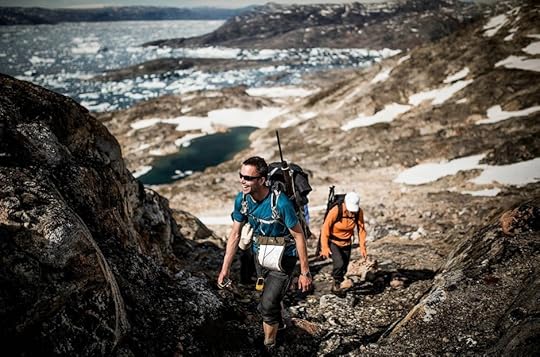
Hikers on Tasiilaq island climbing onto a ridge overlooking the ice fjord and the ice cap on the horizon.

Three local youths from Tasiilaq on an evening climb to the nearby Sømandsfjeldet.
Reaching the trail’s end we came to Tasiilaq, the main town in the region. With a population of 2,000 people, it is the center of the district, and it is a place where people move if they follow the main pattern of migration.
A local hunter from the village of Isortoq invited me on a seal hunt a couple of nights later. Together with his friend Lars Peter, we combed the coastline around town unsuccessfully for six hours on a beautiful summer night. “That’s just what seal hunting is like,” Michael shrugged, powering up his 19-foot boat before carefully pushing and shoving a path through the floes of sea ice that drift south from the Arctic Ocean and block the coastline from the Denmark Strait for much of the summer.

A local tour boat shuttling passengers between the airport in Kulusuk and a trailhead in the Tasiilaq backcountry.

Paulus and his grandson prepare to travel through the Sermilik Ice Fjord in their 16-foot open boat.

Camp managers Michael and Lars Peter on an early morning ride between two hiking camps deep in the Tasiilaq backcountry.

Subsistence hunters on an evening hunt in the summer sea ice near Tasiilaq.

Local hunter and camp manager Lars Peter on a summer morning commute among icebergs traveling from town to a hiking camp in the ice fjord.

An iceberg doubled by the calm waters of the Sermilik Ice Fjord in East Greenland.
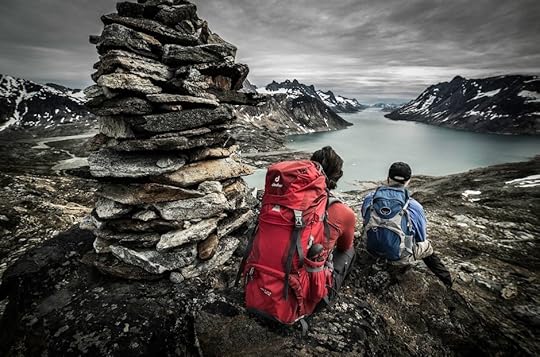
Hikers looking towards Tasiilaq island and the mountains they will have to cross in the coming days.
Back in Tasiilaq for the weekend, I was sucked into the hectic atmosphere of the East Greenland Football Championships — as hectic as it gets with 400 people, or about 10% of the entire population of the east coast clustered around a small gravel surface stadium blasted out of the rock.
People come from the surrounding settlements to the main town for this annual event, and the entire town is turned into one big football tournament for weeks, complete with DJs spinning the favorite tracks of team supporters, makeshift food carts selling everything from hot dogs and noodles to dried fish and seal, and scores of people dressed in the colors of their home team and faces painted with team names and slogans.
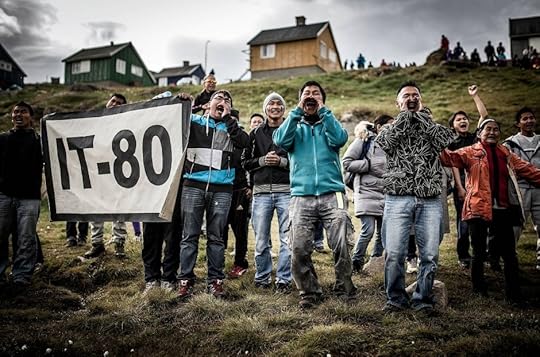
IT-80 football club supporters from the village Isortoq, with just 80 inhabitants, at the annual East Coast Championships in Tasiilaq.

A crucial penalty goal in the Old Boys final at the 2013 East Coast Soccer Championships in Greenland.
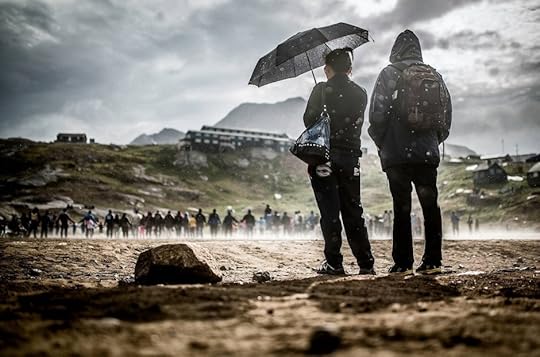
A crowd of supporters gathering in the football field to celebrate the final game of the 2013 East Coast Championships.
Further adventures followed in the coming days before I eventually boarded a flight that traveled over the same landscape I had spent the past two weeks crossing on foot and in boats. Looking down over never-ending ridges and deep fjords and being able to understand the vastness, remoteness, and ruggedness of this place suddenly seemed like the best way to see anything, anywhere.
I headed back out via Reykjavik, which felt like the largest and most bustling city in the world after a deep dive into a region of Greenland not very many Greenlanders have visited. 

June 25, 2014
5 ways to be a greener traveler
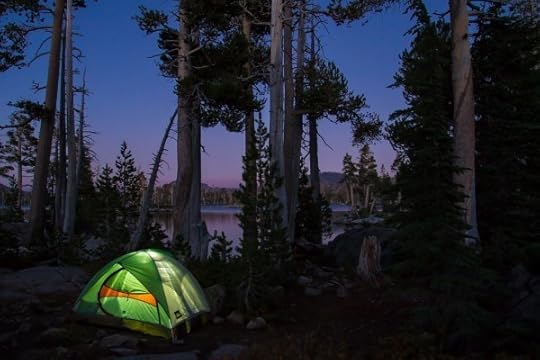
1. Travel slow.
The slow travel movement was started somewhat separately from just trying to reduce environmental impact. It was initially an attempt by travelers to more fully immerse themselves in the places they were traveling by spending more time in a place and allowing themselves to get to know the people and culture, rather than flying in, ticking items off a tourist to-do list, and then flying out. But as it turns out, slow travel is pretty compatible with ecotourism.
By moving slowly and intentionally, you’re likely to spend less time on forms of transport that emit a lot of pollution and greenhouse gases. You may even choose to bike or walk from place to place, if you have light enough luggage. And ultimately, human-powered means of travel are the most environmentally friendly ways of getting around.
2. Know the traveler’s hierarchy of carbon emissions.
If you have to travel in a way that leaves a carbon footprint, try to keep it as small as possible. The Union of Concerned Scientists put together a handy guide for the best way of doing that, and while the best method of getting from place to place changes depending on the number of people you’re traveling with and the distance you’re going, there are some basic rules you can follow.
First, the worst way to travel is almost always by airplane in first class. You’re taking up a lot of space on that plane, and the plane is spewing a lot of bad stuff into the atmosphere. Second, the best way to travel in pretty much all of the scenarios is to take a motor coach. Yes, buses have carbon emissions, but you’re sharing those emissions with dozens of other people. Third, if you have to drive, carpool, and always drive in the most fuel-efficient cars possible. Check out the other tips and travel methods here.
3. “Take only photos, leave only footprints.”
This aphorism changes depending on what you’re doing — for scuba divers, it’s “Take only photos, leave only bubbles” — but the basic sentiment remains the same. The rule is usually geared towards people taking part in outdoor activities, and basically means, “Hey asshole, don’t leave your plastic water bottle in the woods in Yellowstone.” But it can just as easily apply in cities. You should still try to recycle as much as possible, and you should still never litter.
4. Use water like there’s a finite amount of it.
Peak water is a thing, and it turns out those of us living in the developed world use a lot of it unnecessarily. It’s estimated that the minimum amount of water needed for drinking, cooking, bathing, and sanitation per person per day is 13 gallons. The average person in the US uses between 65 and 78 gallons. Honestly, this is an average you should try to work down a bit in your daily life even if you’re not traveling, but it’s important to remember while traveling, too, especially if you’re in a country that struggles with water scarcity.
Most of the ways of doing this are fairly simple. Follow the “If it’s yellow, let it mellow” rule in your hotel or hostel, make sure the hotel doesn’t wash your towel every day, turn off the water in the shower when you’re not rinsing off, turn off the water while you brush your teeth, and so on. For more tips on how to conserve when you travel, check out this post at The Frog Blog.
5. Do your research before you leave.
If you’re planning a short trip or an excursion, make sure you read up on the places you’re going ahead of time. Does that dive shop take care of the local reefs? Is that hotel a known polluter? Is there a way I can give back to the community I’m visiting while I’m there?
Keep in mind that just because something claims to be “ecotourism” doesn’t mean it’s actually helping the environment. Ecotourism is still a niche of tourism, and some less scrupulous tour operators will use the label to pull in well-meaning tourists. You should also keep in mind that many of the ecosystems you travel to may be quite fragile, and that your desire to “get out into nature” and having a low impact on the environment around you may not coincide.
For example, if you were to travel to a national park, you may want to leave the trail to get away from any trace of humankind. But there may be an environmental reason the trail goes through one section of the park and not the other. Know the rules and then follow them when you go. 

Winner of the World Cup [gifs]
But the biggest winner in this World Cup so far is Miguel Herrera, the Mexican team’s head coach. Why? Because he can’t. Stop. Losing. His. Shit.
Here’s Herrera during the Mexico v. Croatia match when the refs didn’t call a handball:

Via Slate
And here’s Herrera celebrating Mexico’s first and second goal:

Via Slate

Via Slate
This isn’t new behavior for Herrera, he’s just had a far lower profile until now. Here’s from when he coached at Club America:

Via r103tr
Let’s hope Mexico’s awesome performance during this World Cup means that Herrera is here to stay. If he’s not, god only knows what he’ll do.


Via Slate

17 stunning Southeast Asian temples
OVER A MILLION AND A HALF square miles, eleven countries, two territories, and one administrative division make up Southeast Asia. Though we typically associate Buddhism with the countries in this part of the world, it certainly isn’t the only faith to be practiced here — in the present or the past.
Thousands of temples of all varieties can be found within this populous sub-region of Asia. And while each is magnificent in its own right, these 17 examples of Southeast Asia’s famously picturesque temples are among the best. 

1
Wat Pho (Bangkok, Thailand)
A Buddhist temple in the Phra Nakhon district of Bangkok, Wat Pho is home to the reclining Buddha (49.2 feet in height and 141 feet in length). The temple, additionally known as Thailand's first public university, is often considered the birthplace of traditional Thai massage.
(via)

2
Pura Ulun Danu Bratan (Bali, Indonesia)
Pura Ulun Danu Bratan is a water temple complex sitting on the shores of Bratan. The temple was built in 1663, and is used for ceremonies honoring Dewi Danu, the water goddess of the Balinese Hindus.
(via)

3
Ta Prohm (Siem Reap, Cambodia)
Widely known as the filming location for Tomb Raider, Ta Prohm was built in the late 12th and early 13th centuries. Trees can be found growing on, climbing over, and wrapping around the stone ruins, which were originally a Buddhist monastery and university.
(via)

4
Tanah Lot (Bali, Indonesia)
Tanah Lot, one of the seven Balinese sea temples, sits on a sizeable offshore rock formation in Tabanan. While considered a must-visit by many, it's worth noting that there's an entrance fee. Additionally, visitors are “forced” to walk through a souvenir market on the way to the temple.
(via)

5
Borobudur (Central Java, Indonesia)
Borobudur, built in the 9th century, is the largest Buddhist temple in the world. It's composed of square platforms topped with circular platforms, and over 500 statues of Buddha can be found around Borobudur.
(via)

6
Pura Besakih (Bali, Indonesia)
Known in English as the Mother Temple of Besakih, Pura Besakih is a complex of 22 temples. In 1963, volcanic eruptions from Mount Agung nearly destroyed the complex, the lava flow skirting the temples by meters.
(via)

7
Cebu Taoist Temple (Cebu, Philippines)
Open to both devotees and non-devotees alike, the Cebu Taoist Temple sits 980 feet above sea level. The entrance pathway to the temple is a replica of the Great Wall of China. The Taoist place of worship was built by Cebu's Chinese community.
(via)

8
Wat Phra That Doi Suthep (Chiang Mai, Thailand)
Located at the top of Doi Suthep, the temple provides for stunning views of Chiang Mai. Though it's often plagued by tourists (for good reason), Wat Phra That Doi Suthep is considered a must-see by most that visit the area.
(via)

9
Buddha Tooth Relic Temple and Museum (Chinatown, Singapore)
The Buddha Tooth Relic Temple and Museum is rather self-explanatory, built between 2005 and 2007 to house the tooth relic of the Buddha. Vegetarian food is served in the basement of the temple.
(via)

10
Wat Arun (Bangkok, Thailand)
Shortened to Wat Arun, the temple's name is actually Wat Arun Ratchawararam Ratchawaramahawihan. It sits on the west bank of the Chao Phraya River, where passersby on boats can see the spires of the temple towering over the nearby surroundings.
(via)

11
Pha That Luang (Vientiane, Laos)
Pha That Luang, found in Vientiane (Laos' capital city), is a Buddhist stupa covered in gold. The stupa is often considered the most important national monument in Laos. Pha That Luang is 147.6 feet in total height.
(via)

12
Kek Lok Si (Penang, Malaysia)
Despite Kek Lok Si containing shops in every direction one may turn, the Buddhist temple remains a sight to see. The seven-story pagoda interestingly fuses Chinese, Thai, and Burmese architectural styles.
(via)

13
Shwedagon Pagoda (Yangon, Myanmar)
One of the most popular tourist attractions in Myanmar, Shwedagon Pagoda contains relics of the four Buddhas inside. The gold on the stupa of the pagoda isn't a cheap paint job—gold plates cover its entirety.
(via)

14
Sri Mariamman Temple (Chinatown, Singapore)
Singapore's oldest Hindu temple is a national monument of the country and is adorned in six tiers of brightly colored plaster sculptures of Hindu deities. The temple is reconsecrated every 12 years.
(via)

15
Thean Hou Temple (Kuala Lumpur, Malaysia)
Found in Kuala Lumpur, the Thean Hou Temple is a Chinese temple dedicated to the goddess Mazu. The six-tiered structure, which took six years to build, cost roughly 7 million ringgit. It officially opened on September 3, 1989.
(via)

16
Wat Rong Khun (Chiang Rai, Thailand)
Known as the White Temple by foreigners, Wat Rong Khun is an atypical Buddhist temple designed in 1997 by Chalermchai Kositpipat. Though the temple was damaged by an earthquake in May of 2014, Charlermchai promised he would repair it to its original state within two years.
(via)

17
Angkor Wat (Siem Reap, Cambodia)
Angkor Wat, situated near Siem Reap, is the largest religious monument in the world. The temple complex was originally a Hindu temple, later converted into a Buddhist temple. The name “Angkor Wat” is Khmer for “City of Temples.”
(via)

Touring Pyongyang, North Korea [vid]
GoPro hasn’t been a thing for all that long, but it feels like virtually every possible use for it has been found already: while bungee jumping, while shark diving, while motorcycling around the world, and so on.
But filmmaker Aram Pan managed to pull a first — he mounted it on a car and then drove around Pyongyang, the capital of North Korea. He managed to get permission from the government to shoot the footage ahead of time, and he presents it here, unedited.
It’s a longer video, so if you want to skip to the highlights, check out some decent shots of the city center at 2:35, massive Soviet-style halls and monuments at 6:30, a Korean version of the Arc de Triomphe at 11:15, and the obligatory-for-all-capitals phallic monument at 14:15. Probably the most notable thing isn’t a sight at all, but how empty the streets are in terms of both people and cars, and how clean they are. 

The 8 types of World Cup spectators

Photo: Peter F.
1. The avid fan
Forged in the fires of domestic and international competitions, these are the purest of the pure when it comes to the game. Knowledge in abundance and a willingness to share it, irrespective of the interest level of those being subjected to it, distinguishes the members of this group.
When two of them meet, there’s no predicting the outcome. Armed with the same facts and love for the game, their view can be swayed by allegiance to club or country, or just a general dislike of certain players (I’m looking at you, Cristiano Ronaldo). Hours will be spent / wasted discussing the ins and outs of the tournament, much to the annoyance of everyone around them.
2. The statistician
“He’s got 5 goals in his last four games but never scores when playing alongside a teammate who currently holds residence in the same country as him.”
“Teams with three vowels in their name never score goals in the first 20 minutes.”
These are examples of the pearls of wisdom the statistician has in their possession. A purist of the sport in many ways, the statistician sees the game as a script just waiting for the players to act out. For them, it’s the knowing that matters and not really the result in the end. Who, what, when, and where have all been decided — it’s just up to the statistician to point out how right they were about it all.
3. The gambler
The World Cup is an unpredictable tournament, with the story twisting and turning on one moment of genius or one unfortunate lapse in concentration. Within this environment of uncertainty and volatility, the gambler can’t be far from the action. Whether it’s with the intent of spicing up the viewing experience of a game they have no vested interest in, or just a gut feeling they have that one particular player will finally score that goal he’s been threatening for the past few games, this is gamblers’ heaven.
The gambler can be found glaring with unusual intensity at seemingly uninteresting games, occasionally muffling sounds of frustration or premature joy as one team or another makes an attempt.
4. The face-painted party animal
Less about the game and more about matching outfits, this curious breed can be found at nearly every match, especially when the host country is a nation like Brazil. Some are supporting teams out of loyalty and years of patriotic watching, whereas others wear the strips of Brazil or Spain because they know summer colours complement their complexion. People with silly hats, team letters crudely drawn on their bodies, and an eye for the camera spend the match making themselves known and trying to elevate the atmosphere as best they can.
5. The part-time prognosticator
Regurgitating paraphrased analysis they overheard at the table beside them in the pub or briefly at the end of the evening news, these are those who have only the most casual association with the sport but will never acknowledge the fact. And they won’t allow that lack of information to affect their contribution to the World Cup banter.
You’ll hear them disagree with common consensus as though privy to some exclusive knowledge or insight, only to eventually wilt back into the shadows as the benefit of doubt gradually turns to disregard.
6. The unaffiliated
Just there for the ride, the unaffiliated tags along for the social occasion. Having no real interest in the sport isn’t enough to save them from getting pulled into the discussion about the validity of penalty calls or whether this or that player is an idiot.
More often than not they say their goodbyes to distracted friends busy berating the TV, slinking back into the safety of their non-football world. The only refuge for these poor put-upon souls are fellow unaffiliateds with whom they can share their woes and just hold tight until this whole nonsense blows over.
7. The saboteur
Unfamiliar with the sport of football in any meaningful sense, the saboteur is there to observe this foreign game, analyse and disassemble it, and compare it to their (superior) sport of choice.
“Rugby players don’t roll all over the place.”
“1 — 0? 2 — 0? What’s the point? I’ll stick with basketball, thanks.”
The key with the saboteur is not to engage. It’s an unwinnable battle that’s been fought for many years, and when it comes to diving, a football supporter doesn’t have a leg to stand on, anyway (unfortunate pun), so it’s best to avoid. If they don’t appreciate this beautiful game for what it is, you’ll never convert them. Just nod politely and turn back towards the TV.
8. The armchair coach
The World Cup is a massive competition featuring some of the most talented and skillful players from all around the globe battling it out physically, mentally, and tactically at the highest level. But such an elite competition doesn’t escape commentary from the armchair coach. With no experience of the game past the age of 12 or 13, they shout pointers and criticism at professional athletes and actual coaches, miming staggering disbelief at the choices made by these giants of the sport.
With in-depth analysis such as, “You should’ve passed it to yer man,” or, “He should’ve put his foot through it,” you can hear them weigh in when the game isn’t living up to their standards. In fairness, they’re generally a creature born from frustration at an underperforming team, but that doesn’t make you want to slap them in the back of the head any less. 

Why Spain is better than the US

Photo: Łukasz Lech
1. They kill it when it comes to friendship.
They’ll always ask you how you’re doing or come hang out with you, things many of my American friends are “too busy” for. They aren’t afraid to show you that they care. When I left my Spanish friends to return home, they got me a Spanish flag and all signed it for me, leaving me surprised, bawling, and smiling all at once.
2. They treat strangers like we treat friends.
Spanish people are some of the most friendly, welcoming people I’ve ever met. I’ve had people go out of their way to help me despite knowing nothing about me, like being picked up at the airport in Barcelona and driven directly to the bus station by a mutual friend I’d never met.
3. Their colloquialisms put ours to shame.
My favorite expletive is me cago en la puta, which translates to “I shit on a whore.” I also like their ways of saying “I don’t care,” like me suda la polla or me la pela. The first one directly translates to “it makes my dick sweat” and the latter to “it jerks me off.” And these are just the swear words I know. Spanish mouths are foul, and Spanish mothers have their work cut out for them.
4. They eat like hobbits.
While I attest that lunch at 2pm and dinner at 9pm is too late for me, it’s really hard to argue with a schedule that suggests you eat five times a day. They have desayuno (breakfast), almuerzo (brunch), comida (lunch), merienda (evening snack / lunner), and cena (dinner). Merry and Pippin would approve.
5. Their food is so much more imaginative.
Spanish food is fucking incredible, and this list would not be complete without mentioning so. In the heat of southern Spain, a bowl of salmorejo will refresh you with its creamy, delicious blend of tomato and bread. And I bet you’ve never imagined that sardines marinated in the perfect ratio of olive oil, vinegar, and salt (boquerones en vinagre) could make you consider selling your body for more.
Then there’s alioli, a simple mixture of garlic (ali) and oil (oli) from Cataluña that could compel you to quote Sandor “The Hound” Clegane on ketchup, the king of condiments.
6. Their grocery stores have their shit together.
Carts in the grocery store require a euro deposit to use. This means fewer people use them and those who do return them. More importantly, they aren’t falling apart and floating around the parking lot denting your car. If you don’t take a cart, you can take a basket WITH WHEELS. Your lazy ass won’t have to carry a thing. Lastly, cashiers have two bagging stations so they can continue checking you out while the person in front of you bags. Cheers to efficiency.
7. One word: Fútbol.
Spain was, until recently, shitting on the entire planet when it came to football. They won the last World Cup, and when the country’s (probably the world’s) two best teams face each other it mandates a countrywide shutdown. Two of their players, Xavi and Iniesta, have basically reinvented the sport as the pulse of Spain and Barça’s tiki-taka style.
Americans wreck at sports and the Olympics but I don’t know how many of our teams generate the worldwide fanaticism that Spain does when it comes to football.
8. They’re better looking than us.
In America, we’ve got California girls and Southern boys, and are home to many an attractive hapa. Regardless, Spain pumps out some fine-ass women and some very handsome men. Can’t really deny that dark, thick, brown hair and tanned, olive skin.
The women always look put together in the latest Zara clothing, and I’ve witnessed many of my female friends drooling over the men’s football bodies and 5 o’clock shadows. It also helps that they don’t have an obesity epidemic.
9. They’re better greeters.
In Spain, when you meet or say hi to a woman you give her two kisses on the cheek, also known as dos besos. You actually have to touch them and bring them into that personal space bubble we Americans value so much. This is just a warmer, more intimate way to greet people.
10. They let their emotions run free.
In America, we tend to bottle up our emotions. We tiptoe around other people’s feelings. Spanish people let that shit out and it’s definitely an emotionally healthier way to be. They’ll tell you how it is and show you how they feel. If they love you, you’ll know. And if they hate you, well damn boy, buckle up.
My friend is being quite literally chased out of her school by her headmistress who left for Madrid to do everything in her power to remove her as a teacher. Compare this to your last American manager who just talked shit about you and fucked with your timetable in hopes you’d become miserable enough to leave.
11. They’re better partiers.
Spain is famous for its parties and it does not disappoint. There’s Las Fallas in Valencia, San Fermín in Pamplona, and more. I got to experience Las Fiestas del Pilar in Zaragoza. All of these involve citywide parties lasting several days full of culture, tradition, and, most importantly, a LOT of drinking.
In a difference of only a few hours, I went from watching a traditional Aragonese dance with a bunch of old people to being shithoused, dancing to electronic music and watching male, female, and transvestite gogo dancers wearing nothing but nipple tape and thongs IN FRONT OF THE CATHEDRAL. I would be lying if I said I didn’t wish my town threw an annual party dedicated to debauchery and copious amounts of alcohol, sprinkled with the history and customs of my people. 

How to piss off someone from Boston

Photo: Tony Delgrosso
Move someone’s shoveled-out parking space holder and take their spot.
This may get you murdered around here. Most apartments in the city don’t come with parking, and finding a spot on the street in good weather is its own miracle. In the winter, it also involves spending an hour heaving yellow snow all over the sidewalk while cursing the weather gods. No one wants to have to do this twice, so it’s customary to lay claim to your spot by placing an item such as an orange cone or laundry basket in it.
So no, that lawn chair isn’t sitting in a perfectly shoveled-out rectangle on the side of the road because someone forgot to pick it up after spending an afternoon people-watching during the polar vortex. Only move it if you want your vehicle destroyed using said lawn chair as a ninja star.
Comment about the slant of the floor, uneven doorways, and lack of central air in your host’s house.
It’s called CHARM, okay? And it’s freaking expensive and you try sleeping at a 30-degree angle every night as the wind comes shrieking through the inch-wide gap around all of your windows.
Same deal with looking for the apartment’s elevator — those didn’t exist when this building was constructed, so you’re going to have to take the stairs. Deal with it. Besides, since there’s no room for a treadmill in my 200-square-foot studio and I can’t afford a gym membership, I’m considering it my new exercise routine.
Talk about the home you just bought in the Midwest or South for the price of my monthly rent.
RUDE.
Underdress and then complain about the cold.
I had a friend from Phoenix who went out in flip-flops on the first day of snow up here because she didn’t understand that snow is cold. NO. I’m not going to go inside with you to warm up every five minutes or let you borrow one of the three down coats I thoughtfully put on before leaving the house. Get your own!
Talk about the Harbor and the Charles being polluted / full of bodies.
We’re past that, and you really need to stop watching so many mob movies. The Harbor has been safe for swimming (and cleared of probably almost all the bodies) for years. Even the Charles was opened up to recreational swimmers last year.
To quote Billy Baker at the Boston Globe, “the bottom of the river remains a toxic mess, but if a swimmer can get in and out of the water without touching the squishy bottom, no tetanus shot is necessary.” We love that dirty water, so step off.
Bitch about all the progressives.
Boston is known for its liberalism. We value human rights, are frontrunners in education and intelligence, and have the best healthcare coverage in the country. To boot, we’re second in hilariousness only to Chicago. Yes, nobody likes the limousine liberals in Newton and Brookline, but they really aren’t what Boston’s all about (that’s why they’re called the 1%).
Attempt to drive without having the directions memorized.
The lane will end abruptly, a rotary will appear out of nowhere, the left-turn-only paint in your lane will be worn off and most likely covered with bumper-to-bumper traffic at all times so you’re unable to see it until there’s no escape. If you’re distracted by trying to read a map, you’ll forget to look both ways when crossing the one-way and someone on a bike will careen into your vehicle, scratch half the paint off, and then scream at you to go fuck yourself.
But let’s get serious, this header should really read: “Attempt to drive in Boston at all.”
Display a complete lack of understanding of our public transportation system.
First, it’s called the T, not the metro or the subway or the underground. Second, give yourself an extra four hours to get wherever you’re going. Part of this is due to perennially disabled trains, and part of it is because of you, thoughtless tourist!
The worst thing you can do is elbow your way to the front door of the aboveground Green Line and then try to pay with incorrect change, out-of-control butterfingers, or your credit card.
Before you go anywhere, purchase a Charlie Ticket at any of the underground stops (or a Charlie Card at one of these locations to save some money). Better yet, just shove through the middle door of the train with all the locals and ignore the request to “come to the front and pay your fare.” The T drivers are way too lazy and apathetic to enforce anything.
Fail to recognize walking and biking in Boston as extreme sports.
I guess walking is your best bet if you want to minimize culture shock, but still be prepared to tunnel your way through the permafrost eight months out of the year as bikes and cars use you for target practice while you’re on the crosswalk. Jaywalking is essential in Boston because none of the lights are on any sort of cohesive schedule, but the key is to never hesitate. Once you make your move, sprint across the street like your life depends on it (it does). Ability to smell fear is the first part of the driving test at the Boston RMV.
Under no circumstances are you to stop on the sidewalk for any reason — not to peer at your map, not to watch a pack of dudes in Red Sox jerseys close in on an unsuspecting Yankees fan (I just got this hat for Christmas! My uncle lives in New York!). Walk single-file and move along!
And if you decide to bike, stay off the sidewalk! We’ve put a lot of money into building new bike paths and lanes all over the city. Yes, driving in the “bike path” on Longwood Ave at rush hour will almost definitely get you turned into human jelly, so check Google Maps’ biking directions for advice on the best route. You really can’t go wrong with a scenic detour along the Charles River Bike Path, the Fens, or the Southwest Corridor.
Smother us in weird friendliness.
Okay, this is totally bewildering. I just met you and you’ve called me sweetheart (I’m not your granddaughter!), blessed my heart six times, and invited me to your wedding. What in the land? On the other hand, don’t look so shocked that we just gave your confused-looking, sun-bonnet-wearing ass directions! Despite the gruff exterior, we’re generally helpful people. 

June 24, 2014
'Big 5' animals from each continent
Big game hunters on trips to Africa often referred to the “Big 5” — the five most difficult African animals to hunt on foot: the lion, the elephant, the Cape buffalo, the leopard, and the rhinoceros. Fortunately, these days, the Big 5 is used less as a to-kill list and more as a to-photograph list for safari-goers in Africa.
But what are the Big 5 for the other continents? What are the must haves for pro and amateur wildlife photographers in North America, for example? Or Australia?
Here’s a list of some of the best / hardest animals to catch on camera for each continent. How many have you shot? Pictures taken at zoos don’t count. 
AFRICA

1
Lion
Although they're usually thought to be an African animal, the lion used to exist throughout Europe and parts of America as well; there are still small populations in some areas of Asia.
Photo: Diana Robinson

2
African elephant
Though still fairly common in sub-Saharan Africa, elephants are vulnerable to conflicts with humans, particularly in the form of illegal ivory poaching.
Photo: Stuart Richards

3
Cape buffalo
The Cape buffalo makes the list because of how aggressive it can be towards humans. Along with hippos and crocodiles, it's considered one of the most dangerous animals in Africa.
Photo: Steve Slater

4
Leopard
Leopards are difficult to find because they're experts at stealth and tend to try and avoid humans.
Photo: Tambako the Jaguar

5
Rhinoceros
The white rhinoceros is the most common species in Africa and gets its name from a mistranslation of the Dutch word for “wide.” As you can see, it’s not really white at all. Rhinos have been known to charge humans and can be skittish in human presence.
Photo: Eugene Wei
NORTH AMERICA

1
Grizzly bear
Grizzlies are the easiest choice for a North American Big 5. They're huge predators and are particularly dangerous.
Photo: Neerav Bhatt

2
Moose
Moose are on the list because of their distinctiveness and also because of their cultural ties to Canada and the American North, although there are also moose in Eurasia, where they're called Eurasian elk.
Photo: Doug Brown

3
Bison
Bison used to virtually carpet the American plains. They were everywhere. Then, naturally, European settlers came and treated them like they were an endless resource, which drove them into endangerment; although, lately, they’ve pulled out of the “endangered” classification, thanks to conservation efforts.
Photo: Kabsik Park

4
Gray wolf
The gray wolf is not exclusive to North America, but I’m putting it on this list due to its cultural ties, especially to the American West. Historically, gray wolves have existed in pretty much all of North America and Eurasia but were wiped out by humans. Lately, they’ve been making a bit of a comeback, most famously in Yellowstone National Park.
Photo: Jason Bechtel

5
Polar bear
The polar bear can be found in Canada, Alaska, Greenland, and pretty much any other Arctic region. They’re on the list because not only are they rapidly losing their habitat, and are thus decreasing in number, but also because they're particularly dangerous, and are known to hunt humans.
Photo: Visit Greenland
SOUTH AMERICA

1
Jaguar
The jaguar is the biggest cat in the Americas. Their habitat extends up into Central America. But they're probably best known for their jungle homes in the Amazon and were culturally important to many early American societies.
Photo: Tambako the Jaguar

2
Caiman
Caimans are members of the crocodilian family that reside primarily in the Amazon. They've been known to feed on humans and also tend to live relatively far off from major human population centers, making them fairly difficult to capture on camera.
Photo: Bernard Dupont

3
Poison dart frog
You’d have to eat a poison dart frog or come into contact with its poison for it to actually harm you. It’s not like it can attack you. But they get on this list because of their insanely vibrant colors and the fact that they're incredibly small, and thus can be tough to spot.
Photo: MoleSon

4
Ocelot
Honestly, ocelots are all over the place in South America, particularly the Amazon. I just added them because I think they’re awesome looking.
Photo: Valerie

5
Anaconda
Probably known best for that absolutely ridiculous Jennifer Lopez movie, anacondas are the heaviest and largest snakes on the planet (though the reticulated python is longer). They pretty much never eat humans, but as they kill through constriction, they probably could if they were big enough.
Photo: Silvain de Munck
ASIA

1
Panda
Of course pandas are on this list. Pandas are culturally connected with China, and though their population in the wild is somewhat precarious, there are a lot of them in zoos and preserves.
Photo: Nathan Rupert

2
Bengal tiger
The Bengal tiger is the largest cat in the world and also one of the most dangerous to humans, though of course humans are more dangerous to tigers. Part of the problem is that they exist in areas with extremely high human population densities, notably Bangladesh and India, both of which consider tigers their national animal.
Photo: Christina Saint Marche

3
Snow leopard
Snow leopards are endangered and are native to Central and South Asia, primarily the Himalayas and other alpine regions. They’re extremely difficult to spot in the wild and tend to avoid humans. There are no known attacks on humans.
Photo: Ben Byrne

4
King cobra
King cobras are the world’s longest venomous snakes and can reach a length of up to nearly 19 feet. They're primarily found in Southeast Asia and prefer to avoid humans but can kill us with their bite.
Photo: Mark Dumont

5
Asian elephant
Asian elephants are generally more docile than their African counterparts and can be domesticated. That said, they're still endangered thanks to encroachment on their habitats by humans and illegal ivory poaching.
Photo: Peter Glenday
AUSTRALIA / OCEANIA

1
Kangaroo
You aren’t going to have much of a problem finding a kangaroo. There are actually almost too many of them, and overgrazing can be a problem in Australia. That said, they’re so iconic they can’t not be on this list.
Photo: Alexis Counsell

2
Orangutan
You’ll have to go to Borneo or Sumatra to see an orangutan in the wild. Elsewhere, they only live in zoos and are critically endangered. Unlike many of the other animals on this list, their endangerment isn't a result of poaching—it’s because of forest fires and deforestation of their natural habitats.
Photo: Makaku

3
Komodo dragon
The Komodo dragon can only be found on the Indonesian island of Komodo and a few others. It’s the world’s largest living lizard, and its bite can be very dangerous thanks to particularly nasty bacteria in its mouth and mild toxins. They've been known to attack humans.
Photo: Yellloh

4
Bird-of-paradise
Birds-of-paradise are extremely colorful birds that are primarily found on New Guinea and a few other Pacific islands. They're incredibly difficult to catch on camera in the wild because they tend to live in dense rainforest, difficult to access in New Guinea.
Photo: Tim Laman

5
Crocodile
Crocodiles could be in the American continents’ lists, or in Africa’s or Asia’s, but I’m putting it under Australia, I’m ashamed to say, for two reasons: Crocodile Dundee and Steve Irwin.
Photo: Tambako the Jaguar
EUROPE

1
Reindeer
Technically, there are reindeer in North America, too, where they’re called caribou. But reindeer are particularly iconic in Russia and the Scandinavian countries, and they’ve become culturally synonymous with European Christmases.
Photo: Soese

2
Lynx
The Eurasian lynx is native to both Europe and Asia and tends to prefer forested areas. It's currently being reintroduced to Western Europe, where it was killed off.
Photo: Tambako the Jaguar

3
Eurasian wolf
The Eurasian wolf is primarily in Russia and the former Soviet Union countries and is a relative of the gray wolf. Like many of the European species, the Eurasian wolf was systematically killed off and can only be found in the less-populated areas of the continent.
Photo: Silvain de Munck

4
Brown bear
The grizzly bear is a type of brown bear but exists mainly in the Americas. The brown bear in Europe, again, is found mostly in mountainous and less-populated regions, meaning primarily Russia and Scandinavia.
Photo: Mark Stevens

5
Urban fox
A quirk of urbanization in many European cities is that urban foxes—red foxes living in urban areas—have shown up everywhere. They're not uncommon, but a good picture is tough to get, so they make the list.
Photo: Hans Watson
THE OCEANS

1
Blue whale
There are a lot of great whale-watching tours around the world, but you tend to not see as much in the way of the blue whale—the largest living animal, and the heaviest animal ever—as there are only around 12,000 in the wild.
Photo: FMyMind

2
Great white shark
Probably one of the most misunderstood animals in the seas, the great white shark can be found in most of the world’s oceans but is tough to photograph unless you manage to catch it leaping out of the water—or are diving with it, which is just not a thing most people want to do.
Photo: Pterantula

3
Manta ray
Manta rays are large eagle rays whose wingspan can reach 18 feet or so. They get a place on my Big 5 list because I’ve always wanted to catch a good picture of a manta ray jumping.
Photo: Chris Zielecki

4
Cuttlefish
Cuttlefish are relatives of squid and octopi, best known for their camouflage and color-changing abilities. That’s why they’re on this list; they’re particularly photogenic.
Photo: Peter Helberg

5
Bottlenose dolphin
Dolphins are among the most intelligent creatures in the world, and there are plenty of them out in the ocean. They’re another particularly photogenic species and often seem to be basically mugging for the camera. If you can catch a photo of them underwater, or airborne, that’s extra points.
Photo: Willy Volk

17 vivid California landscapes
THANKS TO ITS ABSOLUTELY INSANE GEOGRAPHY, California is one of the most starkly diverse places on the planet. In the north you can find temperate rainforest, while in the south lies some of the world’s driest, most majestically barren desert. Driving out of Badwater Basin, the lowest point in North America, you can be at the base of Mount Whitney, the highest point in the contiguous 48 states, within three hours. There are volcanoes and there are beaches — it’s an entire continent’s worth of stunning landscapes in a single state.
And it’s well preserved. The state of California is home to nine of the country’s 59 national parks, as well as over 250 state parks, recreation areas, reserves, and historic sites. So naturally, it’s a good place for a train or road trip. Here are some incredible pictures to get you thinking about where you want to go in California. 
 Our friends at Visit California asked Matador how we #dreambig in California. This post is part of a series we’re publishing to answer that question. Click here for more.
Our friends at Visit California asked Matador how we #dreambig in California. This post is part of a series we’re publishing to answer that question. Click here for more.

1
Death Valley
Death Valley contains the lowest elevation in North America and holds the world record for the highest measured air temperature. And it's staggeringly beautiful at sunrise. A relatively quick drive from the Inland Empire region, it's also close to Sequoia National Park—a totally different biozone. Death Valley is part of the larger Great Basin, and is just to the east of the Sierra Nevada Mountains. The lowest point in North America is at Badwater Basin, and Furnace Creek in Death Valley consistently has the highest temperatures in the United States.
Photo: Tom Babich

2
San Francisco Bay
The San Francisco Bay is one of the most populous regions in the US—and one of the most beautiful. Its most famous landmark is the Golden Gate Bridge, along with tourist areas like Fisherman’s Wharf and the former prison on Alcatraz Island. The city itself is a cultural hub in the region, as are San Jose and Oakland, the two next largest cities after SF. And of course, there's the fog.
Photo: Mike Behnken

3
Mount Whitney
This photo was taken from the John Muir Trail on Mount Whitney, the tallest peak in the continental United States at 14,505 feet. A hiker in good shape can make it to the top and back in a single day, though it's quite a trek—it can take 12-18 hours to complete.
Photo: Peretz Partensky

4
Pfeiffer Beach, Big Sur
Big Sur is a major destination for surfers and has some really incredible coastal areas. This photo, at Pfeiffer Beach, was taken just before a storm. The region itself runs through San Luis Obispo and Monterey Counties, a two-hour drive from the Bay Area and about six hours up the coast from Los Angeles. It’s a relatively sparsely populated area, but an absolute must for road trippers, surfers, and photographers.
Photo: Codex41

5
Joshua Tree National Park
Joshua Tree National Park is named after the yucca trees that were dubbed “Joshua trees” by Mormons passing through the Mojave. They picked the name Joshua because the trees seemed to be extending their arms up to the heavens in prayer. The park spills from the Mojave into the Colorado Desert, which is part of the larger Sonoran Desert. It’s an incredible place for stargazing, thanks to the big, clear skies.
Photo: Nicola

6
Lake Tahoe & Emerald Bay
Emerald Bay is an incredibly scenic section of Lake Tahoe and is set aside as state park land. Tahoe sits on the border of California and Nevada and offers both skiing (winter) and watersports (summer). The lake is also adjacent to Tahoe and El Dorado National Forests.
Photo: Frank Schulenburg

7
Lava Beds & Mount Shasta
This picture shows both Lava Beds National Monument and dormant volcano Mount Shasta. Shasta is close to the much more recently active Lassen Peak, which erupted in the early 20th century, earning the area designation as Lassen Volcanic National Park. Lava Beds is a separate national monument known for its incredible volcanic diversity, including underground lava caves you can tour.
Photo: Michael McCullough

8
Muir Woods
Muir Woods is part of the awesome Golden Gate National Recreation Area, which is in short driving distance from San Francisco and the rest of the Bay Area. Named for environmentalist John Muir, Muir Woods is one of the most easily accessible locations for seeing redwoods. The recreation area around it also includes Alcatraz Island and some seriously scenic coastline.
Photo: Yinghai

9
Malibu
Malibu is one of the best known beach communities in the world. Just outside of Los Angeles, there are a lot of movie stars that live here, so star searchers visit Malibu frequently—for my money, the best thing to do while you’re here is hang out at the beach and surf. Malibu is one of the points connected by the Pacific Coast Highway (see #17 below), and is a great place for cycling as well.
Photo: Neil Kremer

10
Yosemite National Park
The crown jewel of California's park system (and one of the best national parks in the country) is Yosemite National Park. You can see the iconic Half Dome in the center of the photo above. Yosemite has a ton of outdoor activities, from hiking to climbing to downhill skiing. The park is also pretty accessible: It's a four-hour drive from the Bay Area, and just three from Sacramento.
Photo: Vincent Lock

11
San Jacinto Mountains
The San Jacinto Mountains, in the Inland Empire region of the state, has great hiking and skiing. The range serves as the primary geographic barrier for the sprawl of urban Southern California, and as such, is easily accessible from both LA and San Diego. On the eastern side of the mountains is the Coachella Valley, making this a great place to visit if you’re going to the Coachella music festival.
Photo: Bureau of Land Management

12
Mammoth Lakes
A small town in the High Sierra, Mammoth has excellent access to hot springs and skiing. This photo was taken at Wild Willy’s Hot Springs just out of town. Yosemite is a 45-minute drive away, and Kings Canyon and Sequoia National Parks are about five hours off by car (you have to go down and around the mountains). Mount Whitney is only two hours distant.
Photo: Lars Dugaiczyk

13
Bowling Ball Beach
Bowling Ball Beach is on the Mendocino coast in Northern California. This strange rock formation is caused by a process called concretion and is incredibly rare. In addition to some awesome outdoor activities, Mendocino County is famous for its beer and wine production. The beach itself is about a three-hour drive from the Bay Area.
Photo: Josh Hawley

14
Redding
Redding sits in the Shasta Cascade region in the Sacramento Valley, and it's a sweet place to base a trip around Northern California's parks. It also has great biking. It's about three hours outside of Sacramento and is surrounded on three sides by national parks and forests. The picture above is of Brandy Creek Falls, just west of town.
Photo: Ruben Garcia Jr.

15
Anza-Borrego Desert State Park
Anza-Borrego Desert State Park in San Diego County contains portions of the Mojave Desert and the Colorado Desert. It's the second largest state park in the United States, taking up a solid fifth of San Diego County and parts of Imperial and Riverside Counties. There are a myriad of hiking options through its scenic badlands.
Photo: Justin Meissen

16
Napa Valley
California’s Napa Valley wineries are among the best in the world, rivaling French producers (and, in competition, sometimes beating them). It also happens to be pretty beautiful, with rolling green and golden hills that provide a nice backdrop to the symmetries imposed by the vineyards.
Photo: Big D2112

17
Pacific Coast Highway
Less a single landscape and more an experience, the Pacific Coast Highway is one of the most scenic drives in the country. This particular stretch lies between San Francisco and Santa Cruz and features the much-photographed Bixby Bridge, but the road itself runs along most of the length of the state. It starts in Mendocino County and more or less traces the Pacific Coast down to Orange County.
Photo: Chao Yen

Matador Network's Blog
- Matador Network's profile
- 6 followers



